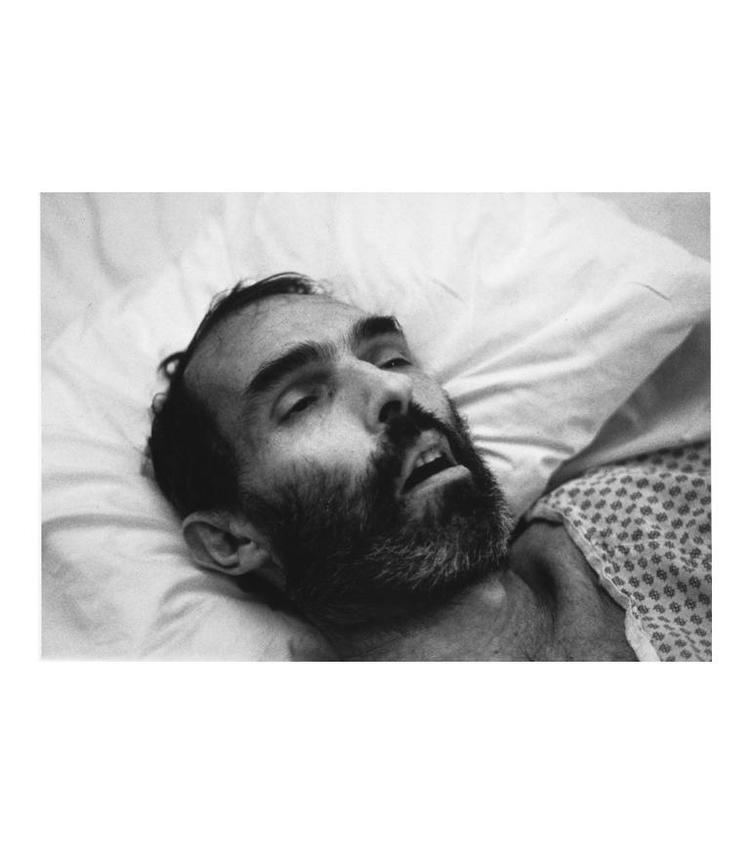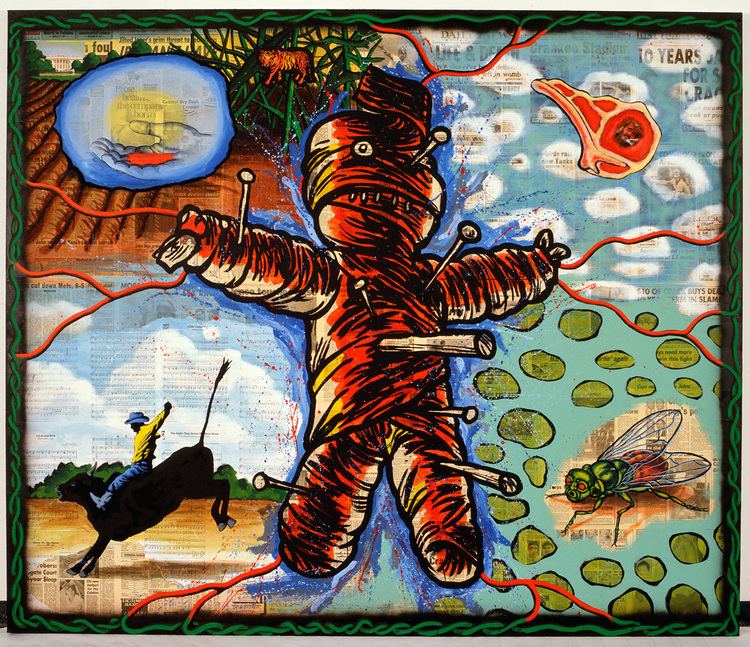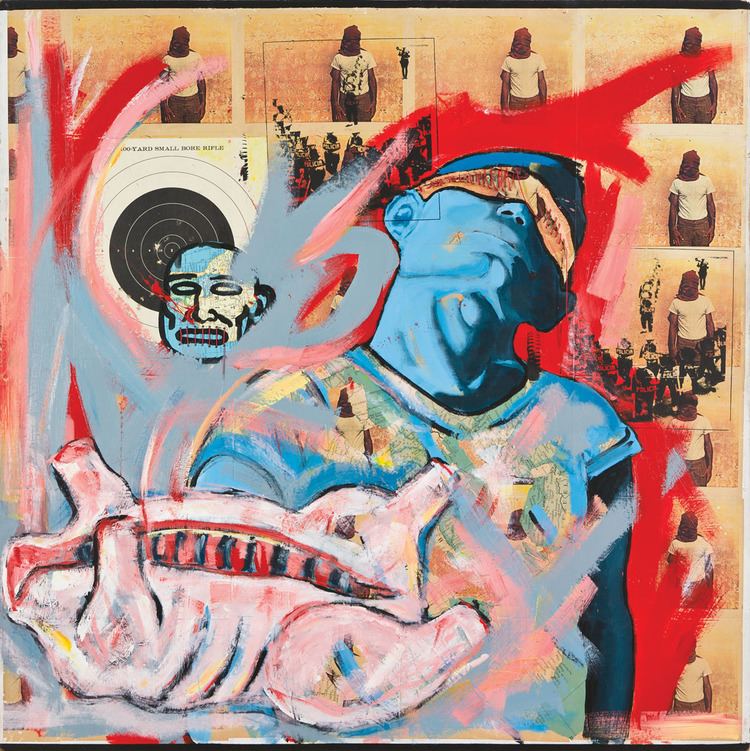Nationality American Name David Wojnarowicz | Role Painter | |
 | ||
Education High School of Performing Arts Artwork Untitled, Fire, Earth, Queer Basher/Icarus Falling, William Morales, Patron of Prison Breaks Movies Fear Of Disclosure, Manhattan Love Suicides, Bust, Beautiful People Similar People | ||
From no alternative 1984 david wojnarowicz
David Michael Wojnarowicz ( ;September 14, 1954 – July 22, 1992) was an American painter, photographer, writer, filmmaker, performance artist, song-writer/recording artist and AIDS activist prominent in the New York City art world.
Contents
- From no alternative 1984 david wojnarowicz
- The true origin of national david wojnarowicz day
- Biography
- A Fire in My Belly controversy
- Response from Clough and Smithsonian
- Response from artists
- Death
- Collective exhibitions
- Books
- Films
- Music
- Critical studies and adaptations
- Archival collections
- References

The true origin of national david wojnarowicz day
Biography

Wojnarowicz was born in Red Bank, New Jersey, and later lived mostly with his mother in New York City, where he attended the High School of Performing Arts for a brief period. A victim of childhood abuse, he lived for a time during his teenage years as a street hustler; he graduated from the High School of Music and Art in Manhattan.

After a period outside of New York, he returned in the late 1970s, where he quickly emerged as one of the most prominent and prolific of an avant-garde wing that mixed media, made and used graffiti and street art; his first recognition came from stencils of houses afire that appeared on the exposed sides of buildings in the East Village. He made super-8 films, such as Heroin, Beautiful People with Jesse Hultberg, began a photographic series of Arthur Rimbaud, did stencil work, collaborated in the band 3 Teens Kill 4 who released the independent EP No Motive in 1982, and exhibited his work in well-known East Village galleries, notably Civilian Warfare, Ground Zero Gallery NY, Public Illumination Picture Gallery, Gracie Mansion and Hal Bromm. Wojnarowicz was also connected to other prolific artists of the time, appearing in or collaborating on works with artists like Nan Goldin, Peter Hujar, Luis Frangella, Karen Finley, Kiki Smith, John Fekner, Richard Kern, James Romberger, Marguerite Van Cook, Ben Neill, Marion Scemama and Phil Zwickler. For some years, until Hujar's death of AIDS in 1987, he and Hujar were lovers. Hujar's death moved Wojnarowicz's work into much more explicit activism and political content, notably around the injustices, social and legal, inherent in the response to the AIDS epidemic.

In 1985, he was included in the Whitney Biennial, the so-called Graffiti Show. In the 1990s, he sued and successfully issued an injunction against Donald Wildmon and the American Family Association on the grounds that Wojnarowicz's work had been copied and distorted in violation of the New York Artists' Authorship Rights Act.

His works include: Untitled (One Day This Kid...); Untitled (Buffalo); Water; Birth of Language II; Untitled (Shark), Untitled (Peter Hujar); Tuna; Peter Hujar Dreaming/Yukio Mishima: St. Sebastian; Delta Towels; True Myth (Domino Sugar); Something From Sleep II; Untitled (Face in Dirt); and I Feel a Vague Nausea among others.

He was also the author of several successful books, often about political and social issues of the 1980s that related back to the AIDS epidemic. One of his bestsellers, "Close to the Knives: A Memoir of Disintegration," is an autobiography made up of creative writings discussing topics from his troublesome childhood to becoming one of the most renowned artists in New York City of his time, to being diagnosed with AIDS himself. While his artwork was his main source of expression, he was able to use many other methods such as books like this one to speak to the public about important controversies of the time.

Wojnarowicz died in his Manhattan home on the night of July 22, 1992, from what his companion Tom Rauffenbart confirmed was AIDS. After his death, photographer and artist Zoe Leonard, who was a friend of Wojnarowicz, exhibited a work inspired by him, entitled "Strange Fruit (for David)".
Wojnarowicz has served as an inspiration to many artists; those that have credited him as an influence include: Zoe Leonard, Victoria Yee Howe, Matt Wolf, Emily Roysdon, Henrik Olesen, Mike Estabrook, and Carrie Mae Weems.
In Spring 2011, P.P.O.W. gallery showed Spirituality, an exhibition of Wojnarowicz's drawings, photographs, videos, collages, and personal notebooks; in a review in The Brooklyn Rail, Kara L. Rooney called the show "meticulously researched and commendably curated from a wide array of sources, ... a mini-retrospective, providing context and clues for Wojnarowicz's often elusive, sometimes dangerous, and always brutally honest work."
A major retrospective, David Wojnarowicz: History Keeps Me Awake at Night, has been announced for exhibition at the Whitney Museum in Spring, 2018. It is co-curated by the Whitney's David Kiehl and art historian David Breslin.
"A Fire in My Belly" controversy
In November 2010, after consultation with Gallery director Martin Sullivan and co-curator David C. Ward but not with co-curator Jonathan David Katz, G. Wayne Clough, Secretary of the Smithsonian Institution, removed an edited version of footage used in Wojnarowicz's short silent film A Fire in My Belly from the exhibit "Hide/Seek: Difference and Desire in American Portraiture" at the National Portrait Gallery after complaints from the Catholic League, Minority Leader John Boehner, Rep. Eric Cantor and the possibility of reduced federal funding for the Smithsonian. The video contains a scene with a crucifix covered in ants. William Donohue of the Catholic League claimed the work was "hate speech", against Catholics. Gay historian Jonathan Ned Katz wrote:
In 1989 Senator Jesse Helms demonized Robert Mapplethorpe's sexuality, and by extension, his art, and with little effort pulled a cowering art world to its knees. His weapon was threatening to disrupt the already pitiful federal support for the arts, and once again, that same weapon is being brandished, and once again we cower.
Response from Clough and Smithsonian
Smithsonian Secretary G. Wayne Clough later in interview states that although he stands by his decision, it "might have been made too quickly" and he describes that making the decision was "painful." Clough mentions that because of heated controversy surrounding the footage and the possibility that it might "spiral out of control", the Smithsonian might be in the end forced to shut-down the entire "Hide/Seek" exhibition, and it's "something he didn't want to happen." The "Hide/Seek" exhibition "examines representations of homosexuality in American portraiture", and Clough states "The funders and people who were upset by the decision, and I respect that, still have an appreciation that this exhibition is up. We were willing to take this topic on when others were not, and people appreciate that."
I think it was very important to cut off the dialogue that was headed towards, in essence, hijacking the exhibit away from us and putting it into the context of religious desecration. This continues to be a powerful exhibit about the contributions of gay and lesbian artists. It was not about religious iconography and it was not about desecration. When you look at the news cycles that take over, their [the show's critics'] megaphones are this big [making a broad gesture] and our megaphone is this big [a small gesture]. We don't control that. And when it gets out of control, you can't get it back.
Clough states "But looking back, sure, I wish I had taken more time. We have a lot of friends who felt left out. We needed to spend more time letting our friends know where this was going. I regret that."
The piece was shown intact when Hide/Seek moved on to the Tacoma Art Museum in Tacoma, Washington.
Response from artists
The curator David C. Ward said: "It is not anti-religion or sacrilegious. It is a powerful use of imagery".
In response, The Andy Warhol Foundation, which had provided a $100,000 grant to the exhibition, announced that it would not fund future Smithsonian projects, while several institutions, including the San Francisco Museum of Modern Art and the Tate Modern, scheduled showings of the removed work.
On December 2, 2010, protesters against the censorship marched from the Transformer Gallery, to the National Portrait Gallery. The art work was projected on the building. On December 5, Michael Blasenstein and Michael Dax Iacovone were detained and barred from the gallery for holding leaflets. On December 9, National Portrait Gallery Commissioner James T. Bartlett resigned in protest. The artist AA Bronson sought to withdraw his art from the exhibit, with support from the lending institution, the National Gallery of Canada, unsuccessfully as of December 20. The curators appeared at a forum at the New York Public Library. A protest was held from the Metropolitan Museum of Art to the Cooper Hewitt Museum. On December 15, a panel discussion was held at the Museum of Fine Arts, Houston. On December 20, a panel discussion was held at the Washington, D.C. Jewish Community Center. On January 20, 2011, the Center of Study of Political Graphics held a protest at the Los Angeles Museum of Contemporary Art. Secretary Clough issued a statement standing by the decision, spoke at a Town Hall Los Angeles meeting, and appeared at a public forum in April 26–27, 2011. Several curators within the Smithsonian criticized the decision, as did critics, with Newsweek arts critic Blake Gopnik going so far as to call the complaints "gay bashing" and not a legitimate public controversy.
Death
On October 11, 1992, David Robinson received wide media attention when he dumped the ashes of his partner, Warren Krause, on the grounds of the White House in protest of President George H.W. Bush’s inaction to fight AIDS. Robinson reported that this action was inspired by Wojnarowicz's 1991 memoir Close to the Knives, which imagined "what it would be like if, each time a lover, friend or stranger died of this disease, their friends, lovers or neighbors would take the dead body and drive with it in a car a hundred miles an hour to Washington DC and blast through the gates of the White House and come to a screeching halt before the entrance and dump their lifeless form on the front steps." In 1996, Wojnarowicz's own ashes were scattered on the White House lawn.
Collective exhibitions
Books
Films
Music
Critical studies and adaptations
Archival collections
The David Wojnarowicz Papers are located in the Fales Library at New York University. The Fales Library also houses the papers of John Hall, a high school friend of Wojnarowicz. The papers include a small collection of letters from Wojnarowicz to Hall.
